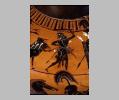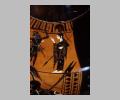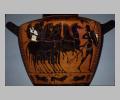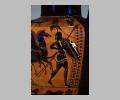| Collection: | Toledo Museum of Art |
| Summary: | Body: chariot, shoulder: Herakles and Cerberus. |
| Ware: | Attic Black Figure |
| Painter: | Attributed to the Karithaios Painter |
| Context: | From Vulci |
| Date: | ca. 530 BC - ca. 520 BC |
| Dimensions: | H. to top of handle 47.0 cm; H. to rim 45.6 cm; D. of rim 23.2 cm; D. of shoulder 29.5 cm; D. of foot 15.5 cm. |
| Primary Citation: | |
| Shape: | Hydria |
| Region: | Etruria |
| Period: | Archaic |
Decoration Description:
Main scene: A chariot turning. The car and the wheels of the chariot are shown frontally, while the bodies of the four horses are in profile, facing right. The charioteer on the left, in the chariot, and the warrior also face right. The heads of the trace-horses are in profile, those of the pole-horses frontal and side by side, their necks turned inward. In front of the horses, on the far right of the scene, is another warrior, on foot, moving right, but looking back left. The charioteer wears a long robe which is belted with tie-strings that cross in front and pass over each shoulder. He holds the reins and a pair of goads in his right hand; his left hand is not visible. A Boeotian shield hangs from his back. He leans slightly forward, gazing intently, as he maneuvers the chariot through its turn. The warrior riding with him wears a high-crested Corinthian helmet and also gazes intently. The warrior on foot wears a high-crested Corinthian helmet, a corslet, a baldric from which a scabbard is suspended, a short chiton and greaves. He carries a pair of spears and a circular shield, its device a tripod. The warriors are bearded, the charioteer is not. Added red: The charioteer's tie-strings, belt and shield border; the upper border and the tail of the helmet-crest of the warrior on foot, the borders of his shield and greaves, and the dots on the skirt of his chiton; the manes and breast-bands of all four horses, the tails of three of them, and part of the chariot. Added white: The charioteer's robe; the baldric of the warrior on foot, his shield device, a row of dots on the inner edge of his helmet-crest, the collar of his chiton and two rows of dots framing an incised pattern on its skirt; the teeth of the trace-horses and patches on the heads of the pole-horses.
Shoulder: Herakles and Cerberus. Herakles (second from right) moves right and looks back at Cerberus whom he leads on a leash. He holds the leash in his right hand and brandishes a club with his left. He wears a baldric over his right shoulder, a sword at his right side and a quiver at his left. Athena, at the far right, stands facing Herakles, her right hand raised; in her left hand she holds a spear pointed downward. Hermes (third from the left) stands behind Cerberus, his left arm raised, the kerykeion in his right. Persephone stands behind Hermes, her left hand raised. Her right arm is bent at the elbow; the fingers of her extended right hand point downward. Behind her, at the far left, stands Pluto. He holds a staff in his left hand; his right arm and hand are muffled in his himation. Added red: Folds in the garments of Pluto, Persephone, Hermes and Athena; the beards of Pluto, Hermes and Herakles; the upper edge of Athena's helmet-crest; dots on the skirt of Herakles' chiton, on the flaps of his quiver and on the ruff of the lion skin; Cerberus' collar. Added white: The flesh of Persephone and Athena; alternate locks of hair on Cerberus' mane; the teeth of the lion skin; the hilt of Herakles' sword, the chape of its scabbard and baldric; dots on Athena's clothing.
Predella: Between upright palmettes (left to right), a boar, a lion and a boar. The boars face inward, the lion faces right. Added red: The shoulders of both boars and a stroke on the rump of the boar on the left; the lion's tongue and dots on its shoulder; the cores of the palmettes.
A band of black tongues appears around the upper side of the mouth (see below). A band of alternating black and red tongues appears at the base of the neck. The lateral borders of the main scene are double rows of ivy leaves. There are two red lines below the predella and rays around the base. The base fillet is painted with added red.
The attribution to the Karithaios Painter was made by Dietrich von Bothmer (cf. AthMitt 81 (1966) 261 and Beilage 22,2The Hearst Hillsborough Vases (Mainz 1969) 43-44
Decoration on the upper side of the mouth, as here, is unusual and is known on only four other hydriai. The tongue-pattern on the upper side of the mouth appears on a hydria in Lyons related to the Antimenes Painter (Studies Presented to David Moore Robinson ii [St. Louis 1953] pl. 17ArchCl 23 [1971] 111-112 and pl. 36
The fourth hydria with decoration on the upper side of the mouth is in Minneapolis (ter.; Minneapolis Institute of Arts Bulletin 51, i [March, 1962] p. 10
Essay:
Collection History:
Gift of Edward Drummond Libbey (50.261). Ex collections Lucien Bonaparte, Prince de Canino, and Vicomte de Janze.
Sources Used:
Other Bibliography:
Notice d'une collection des vases antiques en terrecuite provenant des fouilles faites en Etrurie par feu M. le Prince de Canino, Paris. 4 avril 1843. lot no. 86Collection de M. le vicomte de Janze, Vente Hötel Drouot. 16 avril 1866Art Digest 25 (May 15, 1951) 12AJA 58 (1954) 64Toledo Museum News 5 (1962) 80Toledo Museum News 11 (1968) 36





